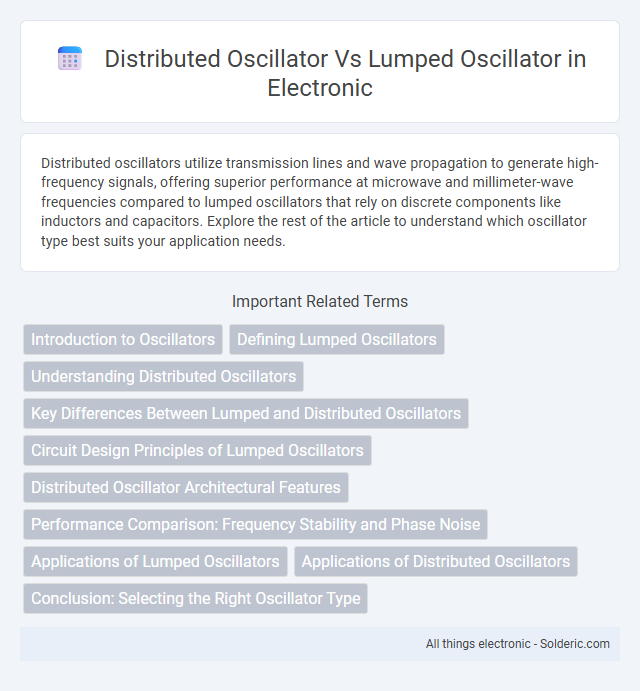Distributed oscillators utilize transmission lines and wave propagation to generate high-frequency signals, offering superior performance at microwave and millimeter-wave frequencies compared to lumped oscillators that rely on discrete components like inductors and capacitors. Explore the rest of the article to understand which oscillator type best suits your application needs.
Comparison Table
| Feature | Distributed Oscillator | Lumped Oscillator |
|---|---|---|
| Resonator Type | Uses transmission lines or waveguides (distributed elements) | Uses discrete components like inductors and capacitors (lumped elements) |
| Frequency Range | High-frequency, microwave to mm-wave | Low to mid RF frequencies |
| Size | Generally larger due to wavelength-scale structures | Smaller, compact due to lumped components |
| Phase Noise | Lower phase noise at high frequencies | Higher phase noise compared to distributed types |
| Power Consumption | Usually higher due to distributed losses | Lower power due to compact design |
| Applications | Microwave communication, radar, high-frequency synthesizers | Low-frequency communication, general RF applications |
| Design Complexity | More complex electromagnetic modeling required | Relatively simpler circuit design |
Introduction to Oscillators
Oscillators generate periodic signals essential for communication systems and signal processing. Distributed oscillators utilize transmission lines or waveguides to support oscillations over a continuous medium, enabling higher frequency operation and better phase noise performance. Lumped oscillators rely on discrete components such as inductors and capacitors, offering simpler design but limited bandwidth and frequency range compared to distributed oscillators, making your choice dependent on specific application requirements.
Defining Lumped Oscillators
Lumped oscillators refer to circuits where inductors, capacitors, and resistors are discrete components localized within a small physical area, enabling predictable resonance behavior based on lumped-element theory. These oscillators operate effectively at lower frequencies since their component dimensions are much smaller than the signal wavelength, minimizing parasitic effects. Compared to distributed oscillators, which rely on transmission lines and wave propagation, lumped oscillators offer simpler design and analysis but face limitations in high-frequency applications due to component non-idealities.
Understanding Distributed Oscillators
Distributed oscillators utilize transmission lines or waveguides to store and transfer energy over a spatially extended structure, enabling higher frequency operation and better phase noise performance compared to lumped oscillators. Unlike lumped oscillators, which rely on discrete inductors and capacitors for energy storage, distributed oscillators exploit distributed reactive elements, making them ideal for microwave and millimeter-wave applications. The design of distributed oscillators often involves traveling-wave resonators or coupled resonator arrays, enhancing frequency stability and tuning range in high-frequency circuits.
Key Differences Between Lumped and Distributed Oscillators
Distributed oscillators utilize transmission lines and wave propagation principles, enabling operation at higher microwave and millimeter-wave frequencies with continuous resonant structures. Lumped oscillators rely on discrete components such as inductors and capacitors for resonance, which limits their frequency range due to parasitic effects and component non-idealities. The spatial distribution of energy storage in distributed oscillators allows for better phase noise performance and higher Q-factors compared to the localized energy storage in lumped oscillators.
Circuit Design Principles of Lumped Oscillators
Lumped oscillators use discrete circuit elements such as inductors, capacitors, and resistors to create oscillations at specific frequencies through energy exchange in a resonant LC tank. Their design emphasizes the careful selection and arrangement of these components to achieve desired frequency stability, phase noise, and amplitude control. Understanding the circuit design principles of lumped oscillators enables you to optimize oscillation performance in low-frequency and integrated circuit applications.
Distributed Oscillator Architectural Features
Distributed oscillator architecture utilizes transmission lines or resonators to achieve oscillation at microwave frequencies, providing wideband operation and improved phase noise performance compared to lumped oscillators. By leveraging spatially distributed components over a physical length, these oscillators enable frequency tuning through delay line adjustments and support higher frequency stability in RF circuits. This architecture is essential in applications such as radar systems and communication transceivers where broadband, low-noise signal generation is critical.
Performance Comparison: Frequency Stability and Phase Noise
Distributed oscillators offer superior frequency stability and lower phase noise at higher microwave frequencies compared to lumped oscillators due to their transmission line-based design, which minimizes parasitic effects. Lumped oscillators, while simpler and more compact, typically exhibit higher phase noise and less frequency stability, especially as operating frequency increases beyond a few gigahertz. Your choice between these oscillator types depends on the required operational frequency range and the criticality of stable, low-noise performance in your application.
Applications of Lumped Oscillators
Lumped oscillators are widely used in low-frequency applications such as audio signal generation, clock generation in digital circuits, and RF communication systems where compact size and simplicity are critical. Their design leverages discrete electronic components, making them suitable for integration in printed circuit boards and microcontrollers. Common applications include crystal oscillators in microprocessors and timing circuits in wireless communication devices.
Applications of Distributed Oscillators
Distributed oscillators excel in high-frequency applications such as microwave communication systems, radar, and satellite transceivers due to their ability to handle signals with minimal loss and dispersion. These oscillators leverage transmission lines or resonators distributed along a physical structure, providing superior phase noise performance and frequency stability at GHz ranges. Your designs benefit from distributed oscillators when precision signal generation is crucial in advanced wireless and high-speed digital circuits.
Conclusion: Selecting the Right Oscillator Type
Choosing between distributed and lumped oscillators depends on frequency range and application requirements; distributed oscillators excel at microwave and RF frequencies due to transmission line benefits, while lumped oscillators are preferred for lower-frequency, compact integrated circuits. Distributed types offer superior phase noise and frequency stability in high-frequency bands, whereas lumped designs provide simplicity and smaller footprint for portable or low-cost devices. The ideal oscillator balances performance metrics like phase noise, size, power consumption, and fabrication complexity relative to the target frequency and system architecture.
distributed oscillator vs lumped oscillator Infographic

 solderic.com
solderic.com